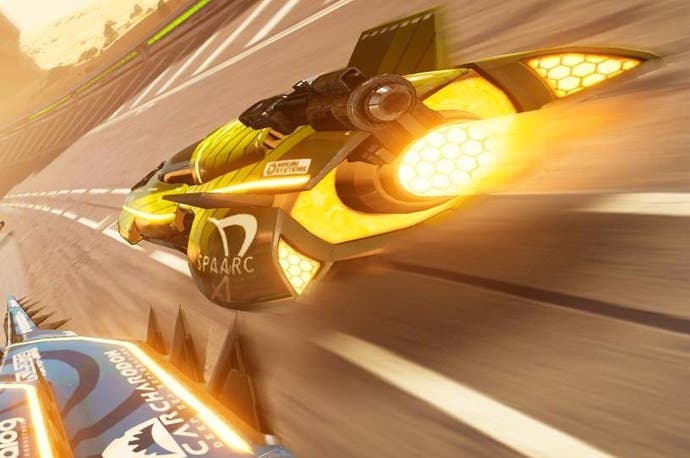Fast RMX showcases Switch's technological leap over Wii U
Massively improved resolution, faster performance, better visuals.
With a launch line-up dominated by Wii U ports, it's difficult to escape the impression that Switch is effectively a handheld version of its last-gen console, albeit built from very different core technology. Since we first went hands-on with the games, the question we've had here at Digital Foundry is pretty straightforward: just how much of a technological leap does Switch actually represent over Wii U? Once developers get to grips with the hardware, what more should we expect from it? Shin'en Multimedia's Fast RMX suggests that Switch has much, much more to offer.
Yes, it's a remake of an existing Wii U title - Fast Racing Neo - but it's most certainly not a straight port. There's commonality in assets, for sure, but what's clear is that the developers have retooled the technical design of the rendering technology to get more out of the Switch hardware. And with this sense of technical innovation, Fast RMX continues a tradition established by a range of spectacular launch titles - all of them racing game. Ridge Racers on PSP, Project Gotham Racing on Xbox and F-Zero on the Super NES all set out to showcase the technological credentials of a new piece of hardware, to spectacular effect. As perhaps the most beautiful portable game ever released, Fast RMX combines fluid performance, impressive visuals and addictive gameplay into a fully featured package.
That package features everything contained in the original Fast Racing Neo - and more. All of the original circuits are present, combined with all the DLC. On top of that there are six new tracks as well - the entire package crammed into just 835MB. Shin'en has a well-deserved reputation for pushing Nintendo hardware in new directions, and in Fast RMX, the team is clearly on a mission here - to extract as much as possible from Switch's mobile Tegra technology. The end result is a substantial increase in visual quality, effectively confirming that Nintendo's new console is capable of so much more than Wii U.
The first major enhancement is resolution. On Fast Racing Neo on Wii U, Shin'en employs a temporal upscaling of sorts, transforming a 640x720 image into a 1280x720 one. Wii U's scaling works but shimmering and combing artefacts are prevalent, giving the impression that the game is running at a lower overall resolution. On Switch, Fast RMX ditches the temporal upscaling technique entirely and instead makes the jump to an adaptive resolution feature, where the game dynamically adjusts rendering resolution based on GPU load.
In docked mode, the game jumps regularly between 900p and 1080p - or even lower in very select circumstances - while portable mode drops the resolution ceiling to 720p where minor drops in pixel-count can also occur, mostly in pre-race fly-bys. From what we understand, there is a small issue with the current firmware on Switch which causes a slight drain on GPU resources - once corrected, we're told that Fast RMX should sustain a full 1080p in docked mode. There's no anti-aliasing as such but the higher average resolution and lack of flickering artefacts on Switch result in a much cleaner presentation.
The presentation itself has been refined as well - the faster GPU featured in the Switch allows the team to implement a more robust atmospheric light scattering system. On Wii U, a simple screen-space approach was used but with RMX, each scene benefits from improved lighting precision and quality. Tracks have a new sense of richness that was missing from the original.
One of the tracks even adds dynamic headlamps to the vehicles during the race - a feature that was not possible on Wii U due to GPU constraints. The weather effects are also enhanced while the windscreen raindrop effect is reworked to appear more realistic than before. Between the improved effects, much higher resolution and enhanced lighting, the world of Fast RMX is more vivid and striking that its Wii U predecessor.
Fast RMX offers support for HD rumble and might just be one of the best examples of the new feature seen in an action game. The vibration effect is well suited to the on-screen racing and really enhances the sensation of playing the game. The effect was created by transforming frequency bands of the original sound effects across multiple vibration frequencies. The frequency bands are then equalised to get the final sensation. The end result is that the mix of sound, vibration and visual stimulation work together to great effect.
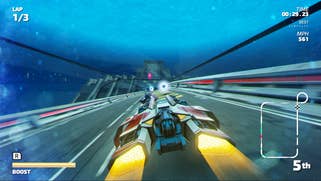

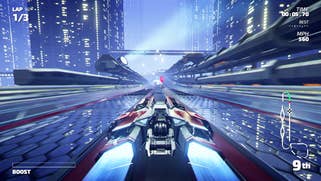
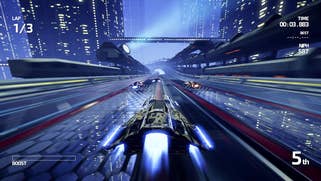


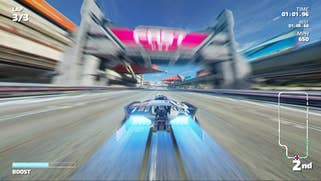

The main menu has also been redesigned with new 1080p assets and improved transitions throughout. An options menu has finally been added allowing players to customise both controls and graphics options. Chromatic aberration and HDR exposure are both options which can be toggled depending on player preference. Loading times are also quick both in docked and handheld mode.
All of this operates at a smooth 60 frames per second whether docked or while gaming on the go. Across hours of play, Fast RMX delivered a rock-solid level of performance throughout in single-player mode. Occasional single frame drops appear from time to time but are virtual undetectable by eye. The Wii U version comes close to matching this as well but certain tracks exhibit minor performance dips into the 50s - something that has been eliminated on Switch.
The performance target is achieved using the adaptive resolution feature. Essentially, when the GPU exceeds 95 per cent of its available resources, the resolution is decreased in 0.001 per cent steps to smoothly transition between various pixel counts. That's roughly one pixel per frame, which continues to drop until GPU resources are below 95 per cent. The game is constantly updating resolution in small increments based on GPU load, eliminating sharp jumps between fixed resolutions in the process.
The various split-screen options also operate at 60fps including three and four player split-screen - an upgrade over the Wii U version which ran the latter two modes at 30fps instead. While local multiplayer generally maintains the same fluid 60fps frame-rate of single-player, we did run across a small handful of momentary drops that persisted for no more than a couple seconds.
The overall impression is that whether you're playing single player or multiplayer, docked or undocked, you can expect a very stable 60fps experience - full refresh isn't just a target here, it's as close as we can reasonably expect to a full lock in single-player mode given the rich visual experience on-screen. That this dogged adherence to 60Hz gameplay remains fully in effect in handheld mode is even more impressive.
It's fair to say that we were really impressed with Fast RMX: this is a beautiful game loaded with content that is a blast to play. While certain titles available alongside the Switch feel overpriced for what they offer, Fast RMX is not one of those. With so much content crammed in the game, Fast RMX might just be the best value title on the eShop right now, and alongside The Legend of Zelda: Breath of the Wild, it's an essential purchase for Switch owners.
